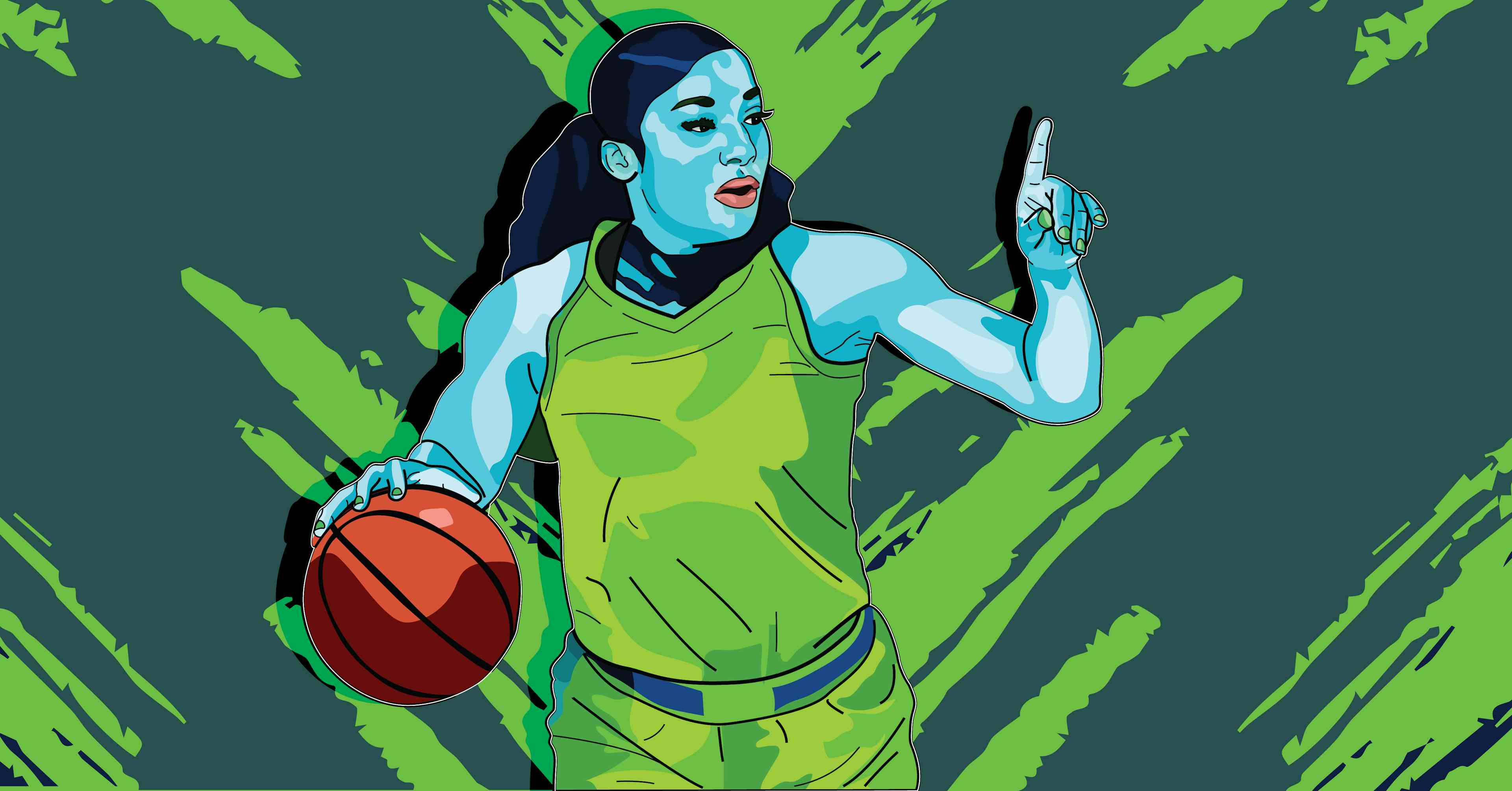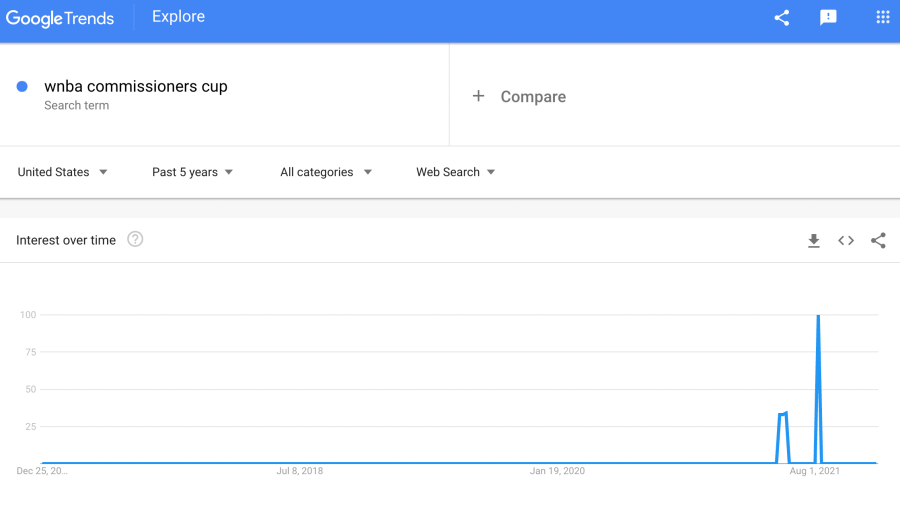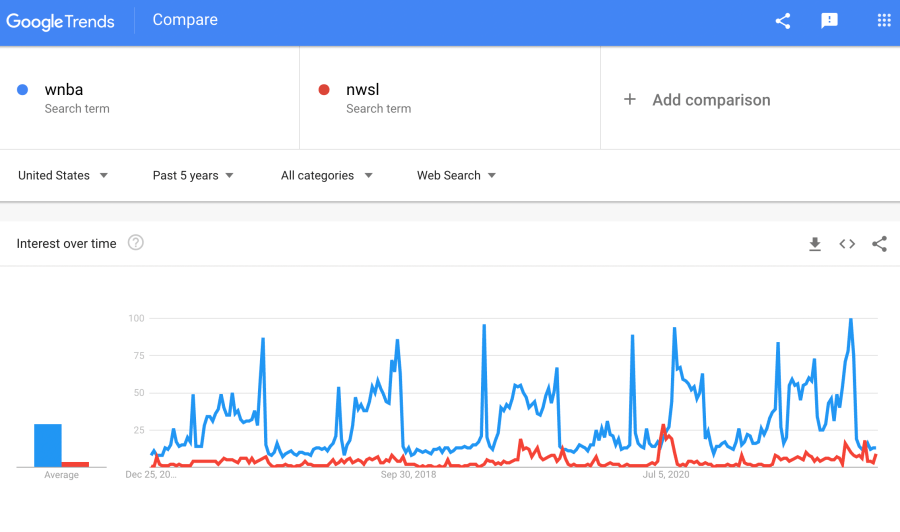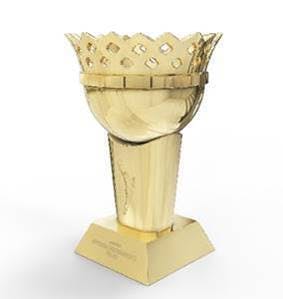

The first ever WNBA Commissioner’s Cup in-season competition kicked off last year in 2021! It’s returning for another season. And this year, the team from each conference with the top record in Cup games will compete for a lucrative prize pool in the Commissioner’s Cup Championship Game on Tuesday, July 26, 2022.
The league launched the new competition as part of their focus on innovation. Excitingly, the 10 designated “Cup games” per team will be the first home game and first road game each team plays against its five conference rivals, all completed from May 6 – July 7. Those wins will determine which teams advance to the first ever Commissioner’s Cup Championship Game in July.
There are not only bragging rights at stake (particularly in the inaugural season). But also there’s a significant prize pool: $500,000. Plus, the winning team will take home a custom designed cup that is passed from champion to champion every season.
“When you’ve got money and bragging rights on the line, I think players are gonna be turnt up and ready to play,” Atlanta Dream co-owner Renee Montgomery told Yahoo Sports.
So today, we take a look at how the Commissioner’s Cup came to be, what exactly it is, and why it’s important. We also reveal the WNBA Commissioner’s Cup standings and leaders to date.
The in-season tournament was first announced as part of the new CBA, in January 2020, and was supposed to begin with the 2020 season.
“We aren’t just adding games. We’re kind of finding ways to garner new fans,” players’ union president Nneka Ogwumike said to ESPN at the time. “The new schedule and Commissioner’s Cup will reflect the progress and innovation we’ve been discussing.”
Each team was scheduled to play 10 Cup games during the season, with the final Cup games played in July. The top team in the Cup standings from each conference would advance to a one-off Cup final in August. But the Commissioner’s Cup was ultimately not held in 2020 due to the pandemic.
“One of the things we promised in the collective bargaining was increased player compensation through special competitions,” commissioner Cathy Engelbert told Yahoo Sports. “So the Commissioner’s Cup is a reflection of that promise we made and the idea to create a special in-season tourney actually came from the players themselves.”
This year though, the Commissioner’s Cup finally came to life.
The WNBA Commissioner’s Cup is an in-season competition that pits Eastern Conference teams against each other, and Western Conference teams against each other. Basically, during the first-half of the WNBA season, 10 regular season games per team are counted towards each team’s record for the Cup. Then, the winners of each conference meet for the grande finale: the Championship Game.
This year’s 10 designated “Cup games” per team will be the first home game and first road game each team plays against its five conference rivals, all completed from May 6 – July 7 during the regular WNBA schedule. The team from each conference with the highest winning percentage in “Cup games” will earn a spot in the Commissioner’s Cup Championship Game.
There are 10 “Cup games” per team and 1 final game.
“I think for the players, it’s actually going to be pretty normal,” Seattle Storm point guard Sue Bird told Yahoo Sports. “We’re used to playing in that system. And hopefully for the fans, it’s just going to generate excitement. You know, everybody loves watching games that mean something. So not only is this, like, a little bit of midseason bragging rights, there’s also money on it. I mean, you can’t get more meaningful than that.”
“Together, we view the Commissioner’s Cup not just as a compelling competition, but as a multi-faceted platform designed to drive opportunities for broader fan engagement, create additional interest around our regular season games, convene around equity and equality themes in our WNBA markets, and provide the players with an opportunity to earn significant cash compensation.” said WNBA Commissioner Cathy Engelbert.
The WNBA Commissioner’s Cup gives regular season play added importance, because from day one of the season, there’s more at stake which could drive more fan interest. It helps bolster rivalries, which helps bolster interest. And a $500,000 purse shows a serious investment in women’s sports that helps cast even more doubt for the “nobody watches the WNBA” crowd (which Nike has something to say about by the way). And interest in the tournament is definitely on the upswing as of late April this year when the competition was officially announced.

However interest still pales in comparison with the amount of attention the NWSL Challenge Cup receives, which is in its second year running and was launched at the height of pandemic boredom in 2020. As you can see below, search volume for the NWSL’s Cup tracks far higher relative to the WNBA’s.
One other key difference with the women’s soccer comparison is that their cup was a distinct event, entirely separate from regular season play. The 10 NWSL teams were organized into two regional divisions of five teams each. Every team played four games within their division, with the two division winners competing in the final, over the course of a month.

But, there’s also the context that the WNBA’s search traffic consistently runs higher than the NWSL’s over the last year.

Presumably, it’s safe to anticipate that in general Cup interest will continue to increase over the years, and will likely sky rocket around the time of the WNBA’s Cup’s Finals in August, when the event feels more distinct from regular season play.
It also provides another opportunity to get the league more engagement from a sponsorship perspective. For example, official sponsors and WNBA Changemakers Deloitte and Google, along with Wilson, the Official Game Ball of the WNBA, will be promoting and activating around the inaugural Commissioner’s Cup events as part of their support for the league’s community-driven initiatives.
Plus, it’s an additional incentive for already highly competitive players to put their best product out on the floor, from the start of the season. “It’s…motivating just as a competitor to have another championship to go for,” Washington Mystics forward Elena Delle Donne told Yahoo Sports.
Though the cup does present some challenges. Typically the beginning of the season is a time to work out kinks and gel on the floor (which is particularly important this year after dramatic free agency shake ups), as well as to put less experienced players in tough game situations for learning purposes. With more at stake, coaches might end up being less willing to take early season risks, and teams immediately have added mental stress.
“I want to make sure that I’m protecting the health of the players, especially the ones that are going to be involved in a lot of games,” Coach Dan Hughes said during a Zoom interview reports the Seattle Times. “I understand the financial rewards, but I also understand if your mission is to be a champion, then that’s probably a higher calling than this.”
Watch the in-season games across network TV as well as on League Pass (see more details on how to watch the WNBA).
Then watch the Commissioner’s Cup Championship Game on Amazon Prime Video beginning at 9 p.m. ET as both teams vie for the half-million dollar prize pool. This exclusive live streaming is part of a multi-year agreement that gives Prime Video international streaming rights to 16 WNBA games per season, including nine Commissioner Cup games and the Commissioner’s Cup Championship Game.
“The Commissioner’s Cup Championship Game is the culmination of the WNBA’s new wildly successful mid-season tournament, and it marks a pivotal moment of the WNBA season—the end of the Olympic break and the starting point for the second half of the 2021 season,” said Marie Donoghue, vice president of Global Sports Video at Amazon. “We’ve seen an overwhelmingly positive response to the WNBA on Prime Video this season, and we look forward to streaming the championship game globally on August 12.”
You can find the latest Commissioner’s Cup standings on the WNBA’s Leaderboard anytime.
The first ever WNBA Commissioner’s Cup Championship Game, took place at the Footprint Center in Phoenix, Ariz., on Thursday, Aug. 12. It showcased the Connecticut Sun against the Seattle Storm, the two teams atop the Commissioner’s Cup standings in each conference.
The first-ever Commissioner’s Cup trophy is a gold-plated cup, that features an11-inch broad crown, a halved 9-inch wide basketball, engraved basketball seams, and a pedestal that features a recessed WNBA logo that sits upon a trapezoid shaped base.
The crown atop the basketball is inspired by a basketball net and intentionally designed with elements of both a net and traditional crown to tie back to the game of basketball, and most importantly, the core focus of competition and crowning a champion.

The Seattle Storm won the 2021 WNBA Commissioner’s Cup, beating the Connecticut Sun 79-57. Breanna Stewart Stewart won the MVP award.
“It felt good,” Sue Bird said. “We will always be the first winner. The Commissioner’s Cup is a good sign of things to come with our league.”
“It’s different because we don’t know how to feel. It is something big what our players just achieved,” Seattle coach Noelle Quinn said. “I loved the confetti, the trophy, it was like a playoff atmosphere and it was great for our league to add this.”
Coinbase Global, Inc. and the Women’s National Basketball Association recently announced a multiyear partnership that makes Coinbase the exclusive cryptocurrency platform partner of the league. The global partnership is the first in the cryptocurrency category for the WNBA. As part of the partnership, Coinbase will become the presenting partner of the WNBA Commissioner’s Cup in-season competition that will take place during the 2022 season.
Stay locked in to see which teams pull ahead and who ultimately wins the cup next season. Up next, learn more about picking a team to root for with our fun guide to becoming a WNBA fan.
Don’t let WNBA stories go untold. Would you be willing to send a $5 tip to our Venmo tip jar because it helps support our reporting? @megsterr.
Or our Paypal: